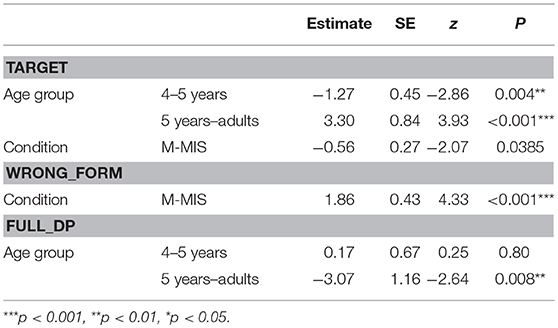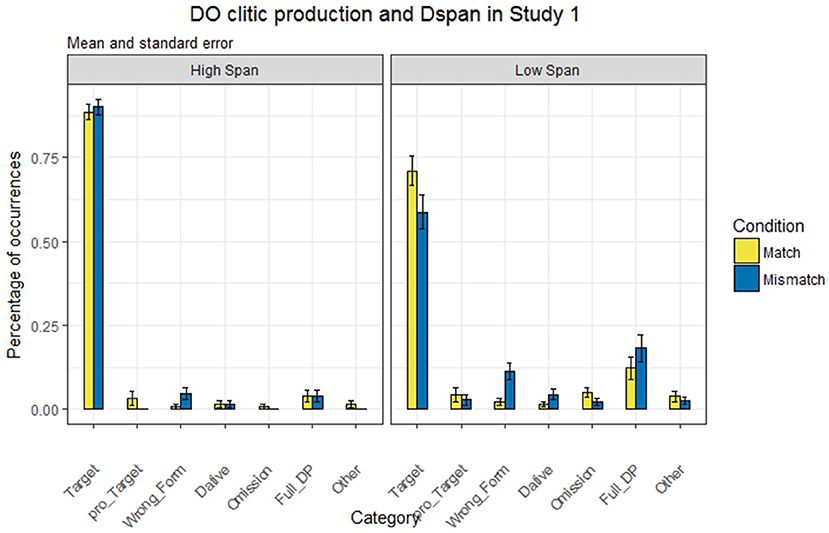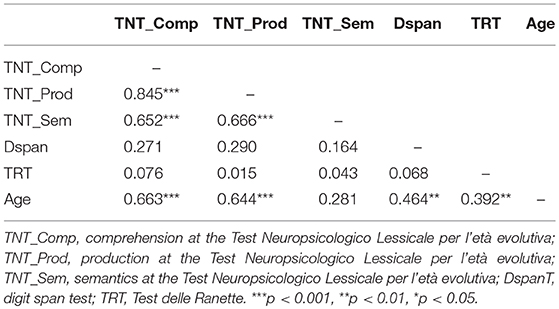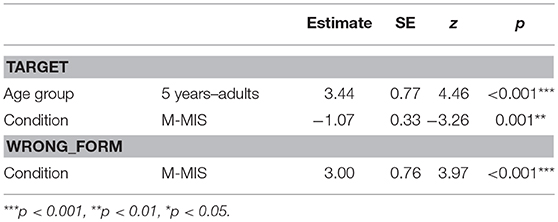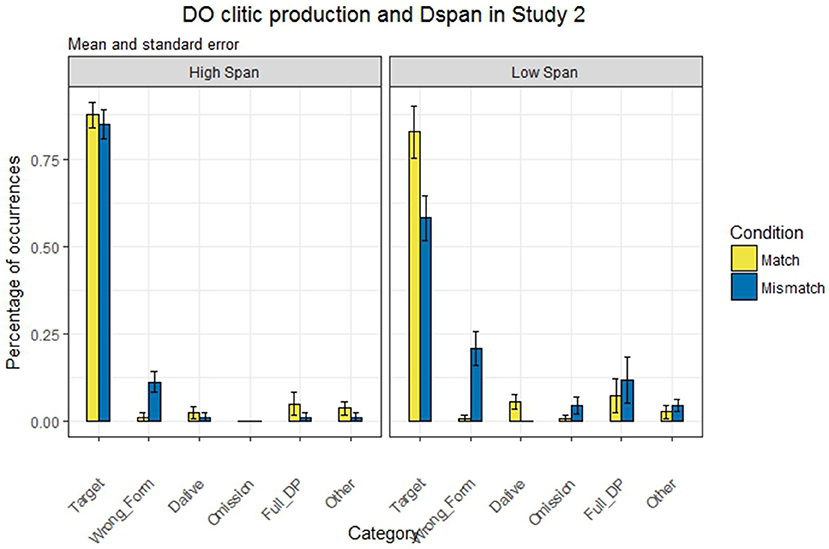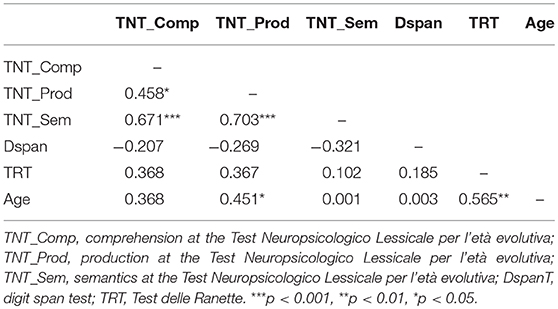- Department of Psychology, Università degli studi di Milano Bicocca, Milan, Italy
Italian speaking typically developing children optionally omit third person direct object clitics (3DO) until at least age 4 years. In a set of two studies, we investigated whether clitic omissions depend on intervention phenomena. We discussed a model of syntactic intervention in 3DO clitic production in which the subject of a sentence might intervene in clitic production at an intermediate stage of the sentence derivation, when the clitic moves from its initial merging position to a higher position above the subject. We argued that omissions and errors in 3DO clitic productions arise when retrieving from memory the clitic to achieve an agreement relation in a context of syntactic intervention. We argued that working memory limitations impact on the clitic retrieving operation cued by lexical and representational features. In Study 1, we elicited the production of third singular clitics in sentences with a full lexical subject. The third singular subject and the third singular clitic were matched or not in gender. Results of Study 1 showed that when there is a gender feature mismatch between the subject and the 3DO clitic children optionally make clitic gender errors or even replace the 3DO clitic with a post-verbal full DP. We argued that these results could be explained in an intervention model in which the external verb lexical argument (the lexical subject) is erroneously retrieved for achieving the agreement operation involving the movement of the clitic to its surface position. In Study 2 we investigated whether the problems in clitic production found in Study 1 depend on phonological priming or structural intervention. We elicited the production of third singular clitics in sentences with a silent pro subject. As in Study 1, the third singular subject and the third singular clitic were matched or not in gender. Results of Study 2 showed that in sentences with a mismatch in gender features between the null subject and the clitic, children tend to produce a clitic with the incorrect gender or to optionally replace it with a full lexical post-verbal DP, regardless of the gender of the target clitic. This suggests that a null subject intervenes in the same way a lexical subject does in the derivation of clitics and, consequently, that the gender features inherited by a null subject via its anaphoric link with its antecedent have the same grammatical status of gender features conveyed at a lexical level. Overall results indicate that the interference errors are not dependent on phonological attraction but rather have a structural nature and are modulated by short-term memory resources.
Introduction
The production of third person direct object clitic pronouns (3DO clitics) is particularly challenging for young Italian speaking typically developing children. Acquisition studies report that instead of producing a 3DO clitic, young children erroneously tend to omit it or to replace it with a full nominal constituent in the canonical verbal object position (Guasti, 1993/1994; Schaeffer, 2000; Leonini, 2006; Caprin and Guasti, 2009; Dispaldro et al., 2009; Moscati and Tedeschi, 2009). Although young children's problems with 3DO clitic production have been attested cross-linguistically, rates of omissions and substitutions differ in different languages (for an overview see Varlokosta et al., 2016).
A number of explanations has been proposed for the omission of 3DO clitics. According to phonological-prosodic accounts, 3DO clitics are omitted since they are functional elements realized by monosyllabic weak morphemes with short duration that are not prone to straightforward grammaticalization [Leonard's surface Hypothesis— (Leonard, 1998) and subsequent research inspired by the hypothesis]; according to Wexler's maturational account (Wexler, 1998, 2003; and subsequent research adopting this hypothesis), young children only achieve one agreement operation on a constituent, and 3DO clitics are omitted in Italian because they are involved in more than one syntactic agreement operation in this language. More recent research argued that the processing, the storing and the retrieval of gender and person features associated to 3DO is challenging for children [see discussion and references in Delage et al. (2016)]. In our study, we will argue that these explanations are problematic and that problems in 3DO clitics production depend on challenging syntactic operations of 3DO clitic derivation. In particular, we will claim that young children have problems with 3DO clitic production because the derivation of sentences with 3DO clitics is generated through a number of intermediate abstract syntactic representations by the application of syntactic agreement operations that are prone to interference phenomena. We will argue that interference phenomena elicit errors and omissions in children's limited working memory system, still under development.
Psycholinguistic research has recently given attention to agreement phenomena in order to investigate the empirical manifestation of intermediate abstract representations generated by syntactic operations during sentence production. Agreement errors described in these studies have been recently explained in terms of problems in retrieving from working memory the target of agreement operations. For instance, Vigliocco and Nicol (1998) showed that some interference errors in subject-verb agreement phenomena are triggered by constituents in abstract intermediate syntactic representations and not in their final surface position. More recent psycholinguistic investigation has showed that the properties and the hierarchical status of intermediate syntactic representations, as modelized in the principles and parameters/minimalist tradition (Chomsky, 1995, 2000), modulate interference errors in subject-verb agreement productions (Franck et al., 2006, 2010; Garraffa and Di Domenico, 2016). These findings have been explained by arguing that during the derivation of a sentence through its intermediate representations, a parsing mechanism temporary stores and retrieves lexical elements from working memory together with their abstract syntactic properties defined by the syntactic context in which they occur (Vasishth and Lewis, 2006; Wagers, 2008; Arnet and Wagers, 2017). According to this model, when the parser proceeds under time pressure or under working memory constraints, it might erroneously retrieve from memory an active intervener sharing syntactic properties and lexical features with the target of a syntactic operation. In our paper we will argue that errors and problems described in 3DO clitic production in early child language are triggered in a similar way: sentences with a 3DO clitic are derived through intermediate abstract syntactic representations generated by syntactic operations requiring to retrieve from working memory lexical elements sharing with an active intervener syntactic properties that are relevant for these operations. Since working memory resources are still under development in young children, we will argue that problems with 3DO clitic production in early child language can be explained in terms of a parsing mechanism that makes use of a working memory retrieval system sensitive to syntactic properties which we assume to be represented as modelized in a principles and parameters/minimalist tradition.
This paper is organized as follows: (i) in order to understand the intervention model we are proposing, we will briefly describe the syntactic principles and operations of sentence derivation which are relevant for clitic production as modelized in a principles and parameters/minimalist tradition; (ii) we will shortly discuss some studies on subject-verb agreement interference and the role of a working memory retrieval system sensitive to syntactic properties that are relevant for our model; (iii) we will describe Italian 3DO clitics and their acquisition across different populations; (iv) we will describe the intervention model of clitic error production, its predictions and the rationale of our study; (v) we will present our study and its results; (vi) we will discuss the results together with their theoretical and clinical relevance.
Sentence Derivation in the Principles and Parameters/Minimalist Tradition: Feature Checking and Agreement
According to the principles and parameters/minimalist tradition (Chomsky, 1995, 2000), sentences are derived through intermediate abstract representations generated by two syntactic operations, Merge and Move. While Merge combines two syntactic objects into a new object, Move moves objects from an already merged position into a new one. According to this model, syntactic objects are endowed with interpretable semantic features and uninterpretable features that are erased under specific structural configurations by a feature checking mechanism called Agree [for an overview see Adger (2003), Adger and Svenonius (2011), Pesetsky and Torrego (2007)]1. Intermediate syntactic representations are generated by Merge and Move in order to erase uninterpretable features under Agree; when all uninterpretable features are erased, the derivation process converges and the resulting structure is prone to semantic interpretation. The structural configuration under which features match and erase is c-command (Reinhart, 1976).

For instance, given a structural relation between nodes A, B, C, D and E as represented in (2), B c-commands C, D and E, C c-commands B, while D and E c-command each other.

In the inventory of uninterpretable features, we find strong uninterpretable features and weak uninterpretable features. According to the Agree mechanism, a weak uninterpretable feature Fů on a syntactic object B is checked and erased when B c-commands a syntactic object C with an interpretable matching feature F. Since, when a node B c-commands a node D, it c-commands all the intermediate projections between B and D [C in the tree in (2)], in order to avoid the potential intervention of an intermediate projection in the agreement relation between two nodes, Agree is constrained by a locality checking condition requiring that a feature Fů on a node B agrees with a matching feature F on D if there is no intervening node C endowed with F (C intervenes between B and D if and only if B c-commands C and C c-commands D). Notice that the locality condition above does not exclude non-local (long distant) agreement. Strong uninterpretable features are only checked and erased under a local agreement relation (the traditional EPP property); a local agreement relation holds between an uninterpretable feature and a matching interpretable feature when the nodes endowed with these features are in a mutual c-command relation. In this case, a strong uninterpretable feature is checked under sisterhood. According to this mechanism, the movement of a syntactic object is motivated and triggered by its being endowed with a strong uninterpretable feature that needs to be checked and erased under local agreement (sisterhood). In this system, while some features on lexical items come from the lexicon with a specific value, some features come without a value and receive their value from a valued instance of the same feature present on another lexical item (for instance the verb agreement with the subject or the adjectival agreement with a noun). In this case, an unvalued feature F on a node B receives its value from the nearest node c-commanding B with an instance of F with a value.
Following this mechanism of sentence derivation, we can assume that the Italian sentence

is derived according to the stepwise intermediate abstract representations as represented in (3a).
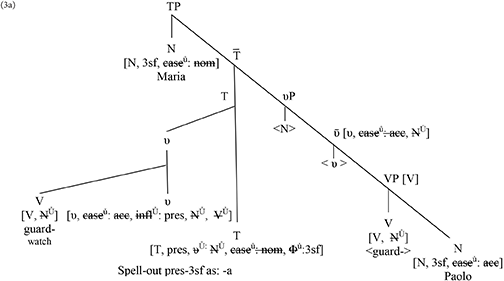
According to (3a), the verb “guardare” (to watch) (actually, its verb stem) is initially merged with its complement, the noun “Paolo”, in order to check its strong uninterpretable categorial selectional feature NŮ. Under the local sisterhood relation (mutual c-command), the NŮ feature on V is checked and erased by entering in the local agreement relation with the categorial feature N on N. The obtained VP, constituted by the verb and its complement, is merged with little υ, a functional projection that enriches the semantic eventive structure of the verb and provides an additional theta argument position for the agent (Kratzer, 1996). υ is endowed with a set of features:
- a categorial feature υ,
- a strong uninterpretable categorial selectional feature VŮ, requiring a local agreement relation between υ and a constituent with a categorial feature V,
- a strong uninterpretable categorial selectional feature NŮ, requiring a local agreement relation between υ and a constituent with a categorial feature N (the external argument to the verbal constituent),
- an uninterpretable accusative case feature (caseů: acc) that need to be checked and erased by valuing an unvalued case feature in its c-commanding domain,
- a strong uninterpretable inflectional feature (InflŮ:) that need to be valued by an inflectional feature in a sisterhood configuration and whose value contributes to the final verbal inflection.
By merging the functional projection υ with VP, the unvalued uninterpretable case feature on the complement of the verb (caseů:) is checked and valued by the c-commanding uninterpretable accusative case feature on υ that is therefore erased2. At this point, the verb moves and adjoins to υ in order to check and delete the strong uninterpretable categorial selectional feature VŮ on υ under local agreement. Then the obtained structure is merged with the noun “Maria” in order to check and delete the strong uninterpretable categorial selectional feature NŮ. In the υP structure, the uninterpretable inflectional feature (InflŮ:) need to be checked and valued. This is done by merging T with υP and then by adjoining υ to T (for discussions about the movement of υ to T in Italian see Belletti, 1990, 1994b, 2009; Zanuttini, 1997; Cinque, 1999). T is endowed with the following set of features:
- a categorial feature T,
- a strong uninterpretable categorial selectional feature υŮ, requiring a local agreement relation between T and a constituent with a categorial feature υ (this is υP in our case),
- an interpretable present tense feature (pres),
- an uninterpretable nominative case feature (caseů: nom) that need to be checked and erased by valuing an unvalued case feature in its c-commanding domain,
- a strong uninterpretable categorial selectional feature NŮ, requiring a local agreement relation between T and a constituent with a categorial feature N (this is the traditional EPP feature requiring the sentence subject to sit in the specifier of TP),
- an uninterpretable phi-feature bundle (Φu) that need to be valued by an interpretable c-commanding phi-feature bundle whose value contributes to the final verbal inflection.
By merging T with υP, the strong uninterpretable selectional feature υŮ, on T is checked and erased by the categorial feature υ projected form the υ head to υP, the uninterpretable nominative case feature (caseů: nom) on T is checked and erased by valuing as nominative (nom) the case feature on υ under agreement, the uninterpretable phi-feature bundle (Φu) T is valued by the interpretable phi-feature of the subject, and the uninterpretable inflectional feature (InflŮ:) on υ is valued for present (pres) by T in a sisterhood relation once υ has adjoined to T. Finally, the strong uninterpretable categorial selectional feature NŮ on T triggers the movement of the subject in the initial sentence position (specifier of TP). At this point, there are no uninterpretable features in the structure and the sentence is prone to semantic interpretation.
According to the minimalist model briefly sketched above, sentences are derived through intermediate abstract representations generated by Merge and Move, two syntactic operations motivated by a feature checking mechanism, Agree. In recent years, a number of psycholinguistic studies has given attention to agreement phenomena in order to investigate the empirical manifestation of intermediate abstract representations generated by syntactic operations as described in this model. In the next section, we will discuss some of these studies and their relevance to our research.
Interference in Subject-Verb Agreement and the Role of a Working Memory Retrieval
Psycholinguistic research has recently given attention to subject-verb agreement phenomena which have been initially investigated in contexts of attraction (Bock and Miller, 1991; Bock and Cutting, 1992; Bock and Eberhard, 1993; see Franck et al., 2006, for an overview). In these contexts, the verb in a sentence tends to erroneously agree with a plural local noun (“books”) occurring between the verb and a singular subject (“editor”) as in (4a).

The structural position of a possible intervener has been shown to be relevant for triggering the erroneous agreement pattern since, when a local noun is not part of the same clause as in (4b), it does not trigger agreement errors (Bock and Cutting, 1992; Nicol, 1995). Vigliocco and Nicol (1998) showed that attraction errors might also be triggered by possible interveners that are active in an intermediate abstract representation of a sentence and not in its final surface representation, as shown in (5a), where the plural local noun “flights” is linearly closer to the verb than the singular subject “helicopter” before the verb moves in the initial sentence position in question formation. Despite their different linear surface representations, (5a) and (5b) share an identical underlying hierarchical structure and, in (5a), attraction takes place before the verb moves in the initial sentence position.

More recent studies combining experimental psycholinguistics and theoretical syntax showed that attraction errors in subject-verb agreement productions depend not only on linear locality and clausal domain but also on hierarchical relations between sentence constituents in intermediate syntactic representations as modelized in the principles and parameters/minimalist tradition (Franck et al., 2006, 2010). For instance, Franck and colleagues (Franck et al., 2006) found that 3DO clitics as in (6a) elicit higher rates of attraction errors than prepositional modifiers as in (6b) in French monolingual adult speakers.

In order to account for these facts, Franck and colleagues assume that the agreement morphology on the verb in (6) is the morphological spell-out of the result of a syntactic agreement operation accomplished in a functional projection (AgrS) inserted at an intermediate syntactic representation of the sentence derivation (Chomsky, 1995). According to this subject-verb agreement mechanism, AgrS is endowed with a set of unvalued phi-features (Φ) that need to receive a value from the subject under a c-command configuration, as shown in the syntactic representations of (6a) and (6b) below.
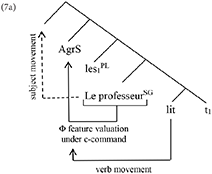
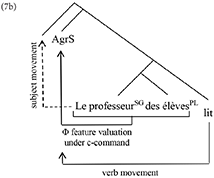
By assuming an analysis of 3DO clitic derivation in which 3DO clitics are pronouns that are initially merged as verb complements and then move to a dedicated functional projection above the verb phrase (Kayne, 1975)3 as in (7a), AgrS is merged above the clitic. In this position, AgrS search for the phi-features of the subject under c-command. However, in this structural configuration, the clitic is also in the c-command domain of AgrS, it is structurally closer to AgrS than the subject (the number of nodes between AgrS and the clitic projection is smaller than between then AgrS and the subject) and it is endowed with a subset of features of the subject, the phi-features. By assuming that during the generation of a sentence through its intermediate representations, a parsing mechanism temporary stores and retrieves lexical elements from working memory together with their abstract syntactic properties, as defined by the syntactic context in which they occur (Vasishth and Lewis, 2006; Wagers, 2008; Arnet and Wagers, 2017), Franck and colleagues argue that, operating under time pressure, the parser might erroneously retrieve from memory the clitic instead of the subject and copy the phi-features of the clitic on AgrS; according to Franck and colleagues, this would explain the large number of attraction errors in sentences like (6a), where a 3DO clitic structurally intervenes between the subject and the AgrS as shown in (7a). Notice, that, once the phi-features on AgrS have been valuated, the verb adjoints to AgrS and the subject moves to the left of AgrS (in its specifier) where, according to Franck and colleagues, checks agreement with the verb in that configuration again. In this final configuration, the clitic occurs linearly between the subject and the inflected verb and act as a potential linear intervener. On the contrary, in (6b), as we can see from its syntactic representation in (7b), the plural modifier of the subject (“des élèves”) does not structurally intervenes in the agreement operation of the valuation of the features of AgrS; it only intervenes linearly once the subject has moved to the specifier of Agrs in order to check the agreement features in that configuration. According to Franck and colleagues, this would explain the smaller number of attraction errors in the production of sentences like (6b)4.
A similar study has been carried out with Italian by Garraffa and Di Domenico (2016). Contrary to French, Garraffa and Di Domenico report that contexts of attraction with 3DO clitics as in (8a) elicit less errors than contexts of attraction with post-nominal modifiers as in (8b) in Italian. In specific, agreement errors were produced in 10.95% of sentences with a number mismatch between the subject and the clitic as in (8a) and in 17.55% of the sentences with a number mismatch between the subject and a post-nominal modifier as in (8b).

However, agreement errors in sentences with a number mismatch between the subject and a clitic were significantly more frequent than errors in sentences with a number match between the subject and the clitic; this indicates that 3DO clitics intervene in subject-verb agreement operations, although they are less disrupting than post-nominal modifiers. In order to explain the asymmetry between Italian and French, Garraffa and Di Domenico assume a model of 3DO clitic derivation proposed by Belletti (1999) in which 3DO clitics move differently in Italian and French. According to this model, in both French and Italian, 3DO clitics are pronouns belonging to the syntactic category of determiners (D), they are merged as complements of a transitive verb and move to a higher position where the verb also moves. According to Belletti (1999), in both French and Italian 3DO clitics move initially as maximal projections and, finally, move to their target position differently in the two languages: as maximal projections in French [they can, therefore, be considered similar to weak pronouns Cardinaletti and Starke, 1999], as heads adjoining to the verb in Italian [see next section for details of Belletti's (1999) analysis]. According to Garraffa and Di Domenico, who follow a memory account of intervention as proposed by Frank and colleagues, 3DO clitics intervene differently in Italian and French due to their different syntactic status: 3DO clitics as maximal projections in French intervene more than 3DO clitics as heads adjoined to the verb in Italian. Although the results of the study by Garraffa and Di Domenico are particularly relevant, since they offer empirical evidence for a theoretical account of 3DO clitic differences in French and Italian, differences in the French and the Italian experimental materials of the two studies might have had an impact on the reported asymmetry. In fact, if Garraffa and Di Domenico (2016) used an Italian translation of Franck et al.'s (2006) materials, gender match between the sentence subjects and the interveners is not the same across items in the two studies, and this might have had an effect. In fact, although gender features are not triggering subject-verb agreement operations in French and Italian, they might be relevant in working memory storing and retrieving processes used by parsing operations, and, therefore, they might have an impact on attraction phenomena. That is, if gender matters in working memory storing and retrieving processes because it is relevant for distinguishing a potential target feature set from an intervening one, the reported asymmetry between the French and the Italian results might depend on differences in gender match between the interveners and the subjects in the French and Italian materials. This issue need to be checked, especially if we consider that plural 3DO clitics used in the two studies are unmarked for gender in French (“les”), while they are marked in Italian (“li” and “le”).
That gender is a potential intervener in agreement operations has been shown in a study with Slovak by Badecker and Kuminiak (2007) and in a study with Russian by Slioussar and Malko (2016). In Slovak and Russian, we find gender agreement between past tense verbs and the subject of the sentence, and, when there is a gender mismatch between the subject and a local modifier occurring between the verb and the subject, the past tense verb tends erroneously to agree in gender with the local modifier as shown in the Slovak and Russian examples below.

Although these studies report different strength of attraction for different gender forms, with feminine local nouns eliciting more errors than masculine and neuter ones (both Slovak and Russian have a tripartite gender system) and although they report that case marking modulate the attraction strength, they show that when the gender features trigger agreement they can act as interveners in the agreement relation much in the same way in which number features can do.
In our study we will argue that problems with 3DO clitic production in early child language result from structural intervention between the sentence subject and the clitic. In particular, we will argue that omissions and errors result from intervention arising in a not yet fully developed working memory system, where storing and retrieving of syntactic items are cued by sets of features including number, gender, as well as syntactic representational information. Before describing our study, we will briefly discuss the cue-based working memory storing and retrieving system used by parsing operations during 3DO clitic production.
Parsing and Cue-Based Working Memory Storing and Retrieving System
According to recent proposals, sentence production is the result of a parsing process that makes use of a cue-based working memory storing and retrieving system (Gordon et al., 2001; Lewis and Vasishth, 2005; Badecker and Kuminiak, 2007). According to this model, a lexical item that enters into the derivation of a sentence is temporary stored in a working memory buffer as a bundle of features and it is successively retrieved in order to achieve syntactic operations at a later stage of the sentence derivation. The retrieval operation in this model is a cue-based retrieval process in which a compound probe, formed by cues including lexical and representational features derived from the ongoing grammatical context, is matched against previously encoded constituents; among representational cues, the system recruits features conveying hierarchical positions in the syntactic structure representation (Franck et al., 2006; Franck, 2018). For instance, in a parsing mechanism that makes use of syntactic representations as described in the principles and parameters/minimalist model (Chomsky, 1995, 2000) analogous to the one assumed by Franck et al. (2006), when the agreement projection (AgrS) needs to value its uninterpretable phi-features, the parser should retrieve from the memory buffer a target candidate of the agreement operation endowed with a set of matching lexical and representational features; that is, an item endowed with interpretable lexical phi-features and syntactic features conveying its hierarchical position in the already parsed intermediate representation of the sentence (this determines its c-command relation with AgrS and its structural distance). During the retrieving process, the target item should be isolated from other items which might share a number of relevant features with it. However, isolating the target may be complicated since other items might be encoded in a way that allows them to resonate to the retrieval cues. In retrieving the target of the AgrS operation, the representational cue of being in the locally highest position in the syntactic structure (c-command) targets both the clitic and the subject. As we discussed, since 3DO clitics in French are in the c-command domain of AgrS, are closer to AgrS than the subject, and are endowed with a relevant subset of features of the subject (phi-features), the parser might retrieve the clitic instead of the target item (the specifier of VP) under certain critical circumstances, such as time pressure and working memory limitations, especially considering that, in working memory, representations decay quickly over time and this can be problematic for memory retrieval operations.
In our study we will argue that 3DO clitic omission in early child language depends on children not yet fully developed working memory resources needed to store and retrieve syntactic items in a syntactic configuration of intervention during 3DO clitic derivation. In order to explain how this might happen and to describe our study, in the next section we will illustrate some features of Italian 3DO clitics, we will briefly sketch some theoretical models of their syntactic derivation and some facts about their acquisition.
Italian 3DO Clitics: Their Features, Their Acquisition, Their Derivation
The pronominal system of Italian includes direct object clitic pronouns (3DO clitics), a set of phonological weak monosyllabic morphemes that realize the direct object of a verb in a position that depends on the finiteness of the verb. Italian 3DO clitics appear in a non-canonical preverbal position and form a phonological word with the verb hosting them when the verb is finite, as in (10).

When the verb is not finite, 3DO clitics appear on the verb in a canonical post-verbal position as shown in the context of the question in (11) where pro is a covert null subject pronoun.

In Italian, 3DO clitics are morphologically marked for person, number and gender and, when the tense of the sentence is the passato prossimo (present perfect), the past participle of the verb agrees in number and gender with them. At the pragmatic level, 3DO clitics denote discourse topics (like all pronouns) and are anaphoric to agreeing discourse antecedents as in (10). These properties mainly characterize 3DO clitic pronouns in Italian. In what follows, we will concentrate on third person clitic pronouns because they have been the focus of extensive acquisition research which has yielded some interesting findings; for instance, a number of studies have shown that the production and comprehension of first and second person direct object clitics is relatively unproblematic, while third person clitics are challenging [see Delage et al. (2016) for an extensive discussion e references found there]. In the next sections, we will sketch the main features of the syntactic theories accounting for Italian 3DO clitics and we will discuss some acquisition data in both typical and atypical language development.
3DO Clitics Derivation
The theoretical description of Romance 3DO clitics has a long tradition and their description is still a topic of an open active debate. In this section, we will sketch the main features of the different approaches to 3DO clitic derivation which are relevant to our study, trying not to address too many complex details. In this broad tradition, we can identify three main theoretical approaches to 3DO clitic derivation: a movement approach, a base generation approach and a mixed approach. According to the movement approach (Kayne, 1975), 3DO clitics are pronouns (D elements) merged in the complement position of the verb, which move to a higher verb-related functional projection in order to check a strong uninterpretable feature they are endowed with, as shown in (11).
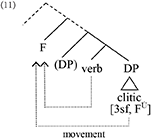
Within this approach, we find different proposals motivating the clitic movement. According to (Belletti, 1994a, 1999) [see also Rizzi (1993)] a strong uninterpretable accusative case feature on the clitic motivates its movement to AgrO, a functional projection above the VP where the strong uninterpretable accusative feature of the clitic is locally checked and erase. According to this proposal, in Italian, the clitic first moves as a maximal projection to the specifier of an aspectual projection (AspP), where the verb moves as a head, and then it moves as a head in AgrO where it cliticizes on the verb, as shown in (12). As we can see in (12), before moving as a head and adjoining to the verb in AgrO, the clitic crosses the external argument position when targeting the AspP projection (and eventually a past participial projection and an auxiliary projection between VP and AgrO). According to the interference mechanism we describe in the previous sections, the movement of the clitic across the external argument is prone to interference phenomena in which features of the external argument might be erroneously retrieved instead of features of clitic: AgrO c-commands both the clitic and the external argument, the external argument is closer to AgrO than the clitic and the external argument is endowed with a subset of features of the clitic.
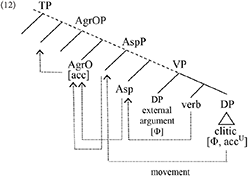
According to more recent minimalist accounts within the movement approach (Mavrogiorgos, 2009; Roberts, 2010), the clitic targets a little υ position, not for valuating a strong uninterpretable accusative feature, but for licensing its semantic specificity associated to its gender and number features [see also Uriagereka (1995) and Sportiche (1992/1996) for a discussion about the requirement that clitics had a specific interpretation triggering their movement]. In little υP, where the verbal predicate is transitivised and the external argument position for the agent is introduced, the clitic adjoints to the verb and moves with the verb as a complex verbal head to the T area as shown in (13). According to these accounts, the movement of the clitic across the external argument should be relatively unproblematic and free from interference phenomena, since the clitic, first targets little υ, a position below the external argument, and then it moves across the external argument as part of a verbal head (TP targets a verbal constituent). Interestingly, while discussing the movement of the clitic to little υ, Mavrogiorgos (2009) argues that if we assume Gallego's (2007) proposal that in null subject languages (as Italian) υ reprojects at the T level generating a complex v*/T head, the clitic would move across the external argument to the complex v*/T head; in this case we expect interference phenomena associated to clitic derivation.
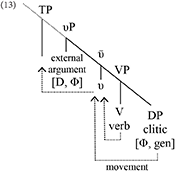
According to proposals in a base-generation approach, 3DO clitics are base-generated in their surface position (Borer, 1983, 1986; Jaeggli, 1986; Suñer, 1988; among the others) and they are agreement markers of null verbal arguments (pro) inserted in a dedicated functional projection (ClP), as represented in (14). Also according to this approach, the production of 3DO clitics is prone to interference phenomena since ClP should establish an agreement relation with a null verbal argument across the external verb argument occurring in an intervening position.
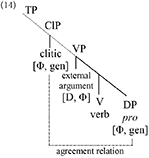
According to proposals in the mixed approach (Sportiche, 1992/1996, 1999) 3DO clitics are functional heads of a clitic projection that should enter into a local agreement relation with a null object (pro), initially merged in the verb argument position5. According to this proposal, in order to enter into the local agreement relation, pro moves to the specifier of the clitic projection as shown in (15a).
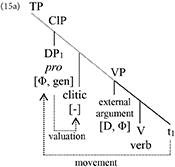
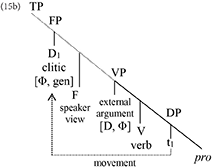
A similar proposal by Uriagereka (1995) assumes that the clitic is the head of a DP complement of the verb and that a pro is the complement of the clitic head as shown in (15b). According to this proposal, the clitic moves to a higher functional projection which encodes “a speaker's point of view” in order to license its dependent pro. As we can see from (15a) and (15b), clitic production in a mixed approach is prone to interference phenomena. According to Sportiche's proposal, pro moves across the external argument of the VP occurring in an intervening position; according to Uriagereka's (1995) the clitic moves across this position. In both proposals, 3DO clitic production is prone to interference phenomena in which the features of the external argument might be erroneously retrieved instead of the features of the target of an agreement operation.
In our study, we will argue that problems in 3DO clitic production depend on processing interference phenomena arising during the achievement of syntactic operations as described in the approaches discussed above. In particular, we will argue that, during clitic production, a working memory system stores the clitic (or pro in mixed and based-generation approaches) and the external verb argument by using cues conveying lexical (Φ) and representational features (c-command); when retrieving the target of the agreement operation, the subject might be erroneously retrieved instead of the clitic (or pro) because of the reverberation of some of its features to the retrieval cues: the subject has the representation features of the clitic (pro) since it is in the c-command domain of the probe, it is closer than the clitic (or pro) to the probe and it is endowed with a subset of lexical features of the clitic (or pro). Since in children we find a not fully developed working memory system and memory traces of items decay quickly in time, the subject might be retrieved instead of the clitic (or pro). Before to describe our study, in the next section we will discuss some acquisition facts that are relevant to our study.
The Acquisition of 3DO Clitics
Italian monolingual children start producing third person 3DO clitics from age 2;0 and they optionally omit them up to 4;0. Rather than producing them, as in (16d) as an answer to the question in (16a), they tend to produce (16b) or (16c) (Guasti, 1993/1994; Schaeffer, 2000; Leonini, 2006; Caprin and Guasti, 2009; Dispaldro et al., 2009; Moscati and Tedeschi, 2009).
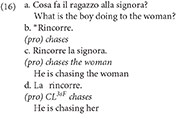
Specifically, instead of producing (16d), younger children tend to omit the clitic and produce an ungrammatical sentence as in (16b), while older children occasionally replace it with a post-verbal full DP (determiner plus noun) as in (16c). Although (16c) is a grammatical sentence, it is infelicitous in the context above since the verb argument is a topic that should be anaphorically realized by a pronoun.
Third person 3DO clitic omission have been attested cross-linguistically in acquisition studies, reporting a more robust stage of omission in a group of languages including Italian, French and Catalan, where the verb past participle in perfect tense sentences agrees with the clitic, than in a second group including Spanish, Greek and Romanian, where there is no past participle agreement (for an overview and discussion see Varlokosta et al., 2016).
A persistent 3DO clitic omission is reported in atypical language development. In particular it is considered a good clinical marker of Specific Language Impairment (SLI) for French and Italian (Jakubowicz et al., 1998; Bortolini et al., 2002; Paradis et al., 2005/2006); problems with 3DO clitic production have been reported in SLI for Greek, a language without past participle agreement (Tsimpli and Stavrakaki, 1999; Tsimpli, 2001). 3DO clitics are consistently omitted in agrammatic aphasic patients in Italian (Miceli et al., 1989; Miceli and Mazzucchi, 1990; Lonzi and Luzzatti, 1993; Rossi, 2007), Venetian Dialect (Chinellato, 2004), Greek (Stavrakaki and Kouvava, 2003) and Spanish (Reznik et al., 1995). Tuller and colleagues (Tuller et al., 2011) found that 3DO clitics are omitted in French-speaking adolescents with mild-to-moderate hearing loss and Rolandic Epilepsy, much in the same way they are omitted in French-speaking adolescents with SLI. These facts show that 3DO clitic production is persistently challenging for language disorders found in different clinical populations.
A number of explanations has been proposed for 3DO clitic omission in both typical and atypical language development and the asymmetry reported between languages with participle agreement and languages without it.
According to prosodic/phonological explanations capitalizing on the work of Gerken (1991, 1994, 1996), 3DO clitics are omitted since they are functional elements realized by unfooted monosyllabic weak morphemes that are difficult to grammaticalize (Bortolini and Leonard, 1996; Leonard, 1998). According to this account, while TD children develop their prosodic skills, produce unfooted weak syllables and are able to phonetically realize 3DO clitics, SLI cannot and persistently omit them. According to a representational variant of a prosodic/phonological account, 3DO clitics are omitted because they are phonologically non-salient phonologically weak morphemes with short duration, that are difficult to grammaticalize. According to this account (Leonard's Surface Hypothesis—Leonard, 1998), while omission is a temporary phenomenon in TD, it is persistent in children with SLI because of limitations in the processing of non-salient phonological inputs making clitic difficult to be grammaticalized. Prosodic/phonological explanations have been challenged by studies comparing the production of 3DO clitics to the production of functional morphemes with identical prosodic/phonological features, such as determiners, reflexive clitics, subject clitics and first and second person DO clitics. According to these studies, children have less problems in the production of reflexive clitics, subject clitics and definite determiners (Hamann et al., 1996; Jakubowicz et al., 1998; Bedore and Leonard, 2001; Audollent and Tuller, 2003; Smith et al., 2008; Zesiger et al., 2010; Gavarró, 2012; Arosio et al., 2014), and they have less problems with the production of first and second person DO clitics (Tsimpli and Mastropavlou, 2007; Zesiger et al., 2010; Coene and Avram, 2011; Tuller et al., 2011; Gavarró and Fortón, 2014; Delage et al., 2016).
Observing that in the first group of languages we reported at the begin of this section the verbal past participle agrees with a 3DO clitic and in the second group does not, Gavarró et al. (2010) proposed that 3DO clitic omission in these languages is the result of a constraint, which limits the number of agreement operations that children can perform in a sentence to one (Unique Checking Constraint: Wexler, 1998, 2014). According to Gavarrò and colleagues, 3DO clitics are agreement markers inserted in a syntactic projection called ClP that should establish an agreement relation with a null object pro inserted as a DP complement of the verb [see Sportiche (1992/1996) and the discussion in the previous section]. While in languages without participle agreement the null object pro is only involved in an agreement operation with ClP, in languages with participle agreement it is additionally involved in a second agreement operation with a syntactic projection where the agreement with participle is computed, as shown in (17), represented in (18). According to Gavarró et al. (2010), while 3DO clitic production is relatively unproblematic in languages without past participle agreement, it is blocked in languages with participle agreement since the double agreement operation of pro with the verb participle and with the clitic in ClP leads to a violation of the Unique Checking Constraint. In order to fulfill the Unique Checking Constraint, one of the two agreement elements can be deleted during the derivation of the sentence. These are the verb participle agreement projection and Cl. If Cl is deleted, pro will establish agreement with the past participle and a clitic will not be produced; for Italian this will be a violation of the requirement of having overtly realized argument of transitive verbs and it predicts morphologically marked participles in sentences with 3DO clitic omission as in (19). Alternatively, if the verb participle agreement projection is deleted, pro will only agree with Cl. In this case, a 3DO clitic will be produced without agreement with the verbal participle; this predicts 3DO clitic production in sentences with morphologically unmarked participles, as in (20).
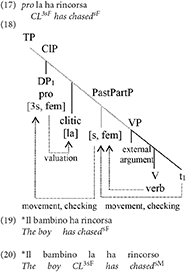
Sentence (19) and (20) are only optionally produced, as children between 3 and 5 also produce sentences like (16d). To explain this fact, Gavarró et al. (2010) appeal to another constraint: Minimize Violations, whereby children will have to choose a derivation that leads them to violate as few constraints as possible. (19) violates the constraint that requires expression of the verb argument; (20) violates the constraint that requires checking agreement and (17) violates the Unique checking constraint. Since each sentence violates the same number of constraints, one, children are free to choose any of the three, hence the optionality. While sentences with participle agreement errors as in (20) have not been reported in acquisition studies, some errors in sentences with 3DO clitic omission as in (19) are attested. For instance, Schaeffer (2000) reports 100% of correct participle agreement production in sentences with 3DO clitics and 80% of agreement errors in sentences with 3DO clitic omission in 2 years old Italian monolingual children; Moscati and Tedeschi (2009) report 75.9% of correct participle agreement production in sentences with 3DO clitics and 80% of agreement errors in sentences with 3DO clitic omission in 4 years old Italian monolingual children. These facts are problematic for Gavarró et al.'s account of 3DO clitic omission in Italian. Moreover, since past participle agreement in Italian does not occur in simple tense sentences like (10) and (16d), Gavarró et al.'s proposal should assume that, in languages with participle agreement, there is an extra projection in simple tense sentences that is not present in languages without participle agreement, where agreement with the null object pro is checked without any morpho-phonological expression. Without this assumption, 3DO clitics are predicted to be more easily produced in simple tense sentences than in passato prossimo sentences, a prediction not borne out by facts since no asymmetries have been reported for Italian (see for instance Arosio et al. (2014) for both typical and atypical language development in Italian).
Given these problems, in our study we investigated an alternative account by considering an explanation of 3DO clitic omissions based on morphosyntactic complexity and intervention as discussed in the previous sections. This explanation is inspired by the work of Zesiger and colleagues (Zesiger et al., 2010) who argued that the production of 3DO clitics is particularly challenging because it requires the accomplishment of morphosyntactic operations ending up in a syntactic configuration where an argumental chain from the object position to the clitic crosses the subject as shown in (21).

According to Zesiger and colleagues, the chain crossing configuration explains 3DO clitic slower acquisition in terms of large processing costs. Moreover, 3DO clitics are arguments located in a preverbal non-canonical position receiving theta assignment via a chain, linking them to their original merging position. In our study, we investigated which factors make a chain crossing configuration challenging for young Italian speakers. In particular, we considered the agreement operations that trigger movement ending in a chain crossing configuration. We will show that this explanation is compatible with both a base-generated approach of 3DO clitic derivation (Borer, 1983, 1986; Jaeggli, 1986; Suñer, 1988), a movement approach (Kayne, 1975; Rizzi, 1993; Belletti, 1994a, 1999) and a mixed approach (Sportiche, 1992/1996, 1999; Uriagereka, 1995). In all approaches, an agreement relation between a projection above the VP and a constituent located in verbal object position should be established across the subject in order to trigger its movement during an intermediate stage of the sentence derivation. In order to achieve this operation, the constituent located in verbal object position should be retrieved from working memory while the subject acts as an intervener due to its syntactic position and its features6.
As we observed, this happens in the three approaches of 3DO clitic derivation we discussed above. For the sake of the discussion, we will follow a mixed generation approach to 3DO clitic derivation as originally proposed by Sportiche (1992/1996) without entering into many details. According to this analysis, 3DO clitics are agreement markers of a silent pro which is inserted in the derivation of the sentence as the internal verb argument with a strong feature that needs to be checked locally and overtly in a dedicated projection, as shown in (15a). The silent pro is a verb complement that differs from full lexical DPs (determiner + noun) since the former one has a strong uninterpretable feature that should be checked locally and overtly in ClP (or in an equivalent functional projection in the other accounts), while the latter ones not7. Under this analysis, while the production of a lexical DP is relatively unproblematic since it is not prone to interference phenomena, the production of a 3DO clitic is challenging since it requires to handle a complex agreement configuration in which an item (the external verb argument) in a target position less distant than pro, sharing a relevant subset of lexical features with pro, intervenes between the pro and ClP. When producing a sentence with a 3DO clitic the parser should retrieve from memory pro, an element that might be difficult to distinguish from the external verb argument for the above reasons. Under these circumstances, the production of 3DO clitics is presumably more problematic than the production of lexical complements in children with limited processing resources. Beyond memory resources needed to maintain in working memory a complex syntactic structure, to access and manipulate elements, abilities to inhibit highly accessible but not relevant information, such as the features of the subject might be relevant for accomplish agreement operations in contexts of intervention. Therefore, under limitation of processing resources, the intervention model we described so far predicts that children might retrieve the subject and thus produces a 3DO clitic with a wrong number/gender morphology when there is a feature mismatch between the clitic and the subject; alternatively, they can produce a lexical DP in order to avoid the intervening structure or, in more drastic cases, they can delete ClP and produce an ungrammatical sentence without an overtly realized verb argument. These predictions are in line with recent findings by Delage et al. (2016) showing that young French-speaking children produce clitic sequences with wrong gender morphology when there is a gender mismatch between a subject clitic and a 3DO clitic in a sentence and are consistent with recent research reporting a link between measures of verbal working memory and clitic production (Grüter and Crago, 2012; Mateu, 2015).
In order to investigate the plausibility and the predictions of the interference account of 3DO clitic omission we described above, in two studies we elicited the production of 3DO clitics in a group of in monolingual Italian children aged 4–6 years and a group of adult controls. The third singular subject and a third singular 3DO clitic were matched or not in gender. In Study 1, we elicited the production of third singular 3DO clitics in sentences with a full lexical subject as in (21). In Study 2, we elicited the production of third singular 3DO clitics in sentences with silent pro subject as in (16d) in order to investigate whether features inherited via an anaphoric relation and lexical features play similar intervention effects. In order to evaluate whether processing resources impact on 3DO clitic production, children were additionally tested with an auditory inhibition task and a verbal short-term memory task. The intervention model we described so far predicts a higher number of errors in the mismatch condition and an impact of processing resources on error rates.
Study 1: 3DO Clitic Production With Lexical Subject Intervention
In Study 1, we elicited the production of 3DO clitics in sentences with a lexical subject; children were additionally tested in four tests measuring their verbal and non-verbal cognitive abilities. These were the Test Neuropsicologico Lessicale per l'età evolutiva (TNL) (Cossu, 2013), the standardized Raven's Colored Progressive Matrices test (CPM, Raven et al., 1998; Italian standardization by Belacchi et al., 2008), a short-term memory digit span task (DspanT) and the Test delle Ranette (TRT) (Marzocchi et al., 2010). The TNL is a standardized test evaluating lexical and phonological abilities in Italian speaking children aged 3–9 years; the test is organized in four tasks evaluating lexical abilities in comprehension and production and semantic and phonetic/phonological fluency. Raven's CPM test evaluates non-verbal cognitive abilities. The DspanT valuates children's short-term memory resources; in the DspanT children are required to repeat sequences of digits of increasing length, pre-recorded by a native speaker of Italian and played through loudspeakers at a pace of one digit a second. The TRT is the standardized Italian version of the Walk Don't Walk Test (Manly et al., 1999) evaluating children's attention and response inhibition. In the TRT, children are required to follow a path on a paper using a pen, proceeding step by step, in synchrony with a tone sequence, where unpredictably tones ending differently than the others signal the child to stop on his path.
Participants
Forty-five typically developing monolingual Italian children aged 4–6 years and eleven Italian monolingual adult controls were tested in Study 1. Children were divided into two groups according to their age: a group of twenty children aged 4;0 to 5;0 years (M = 4;6, SD = 3.6 months) and a group of twenty-five children aged 5;1 to 6;0 years (M = 5;5, SD = 3.5 months). Children were recruited from schools and kindergartens in the area of Milano and Como (Italy). No child was receiving clinical services. All children had a non-verbal IQ within normal limits as measured by Raven's matrices and they all have age appropriate scores at the TNL and the TRT. Children's scores are reported in Table 1. Children were tested in a quiet room at their schools in three different sessions on different days within 2 weeks. Written informed consent was collected from children's parents and from the adult participants before testing. The study was approved by the Ethics Committee of the University of Milano-Bicocca (prot. 20974/13) according to the standards of the Helsinki Declaration (1964).

Table 1. Background information for the three groups of participants in Study 1: mean age; raw score means, centiles and standard deviations (SDs) at Raven's; DspanT raw score means and SDs; TNL raw score means, T-point means and SDs at lexical comprehension task, lexical production task and semantic fluency task; raw score means, centiles and SDs at the TRT (centiles for the 4 year olds are not available since the test is standardized for children older than 5 years).
Materials and Procedure
In Study 1, we tested the production of twenty sentences containing a lexical subject and a third singular 3DO clitic. In this task, we manipulated the gender of the subject and the gender of the clitic in a 2x2 experimental design. We selected forty transitive lexical verbs and created twenty contexts eliciting five sentences per condition. Examples of elicited sentences in the four conditions are reported below
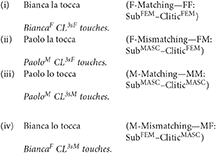
During the elicitation task, children were presented triplets of drawings with two characters, Bianca and Paolo, a girl and a boy who performed some actions. While watching the first drawing representing Paolo and Bianca, children heard a sentence saying that the characters would perform two transitive actions. While watching the second drawing showing one of the characters acting upon someone, children heard a sentence describing the first action the character was performing. While watching the third drawing showing the other character doing the second action to someone, children heard the expression “and then …,” prompting them to continue the story by describing what was happening. A trial example is represented below:
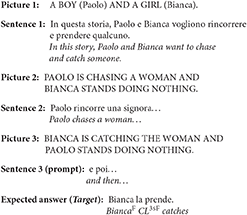
In the experimental context, a felicitous continuation of the story is a sentence with an overt subject and a 3DO clitic. This allowed us to investigate whether a gender mismatch between an overt lexical subject and a 3DO clitic impacts on children's ability to produce sentences containing 3DO clitics. Descriptions and eliciting prompts were digitally recorded by a male native speaker of Italian and played through loudspeakers connected to the PC. The 20 experimental trials were randomly ordered. Three familiarization trials preceded the experimental session; feedback was given during the familiarization session when needed.
Response Coding
Children's responses were classified into seven different categories. Responses were considered as Target when they matched the target responses (i.e., children produced a sentence containing an expected overt subject and a 3DO clitic with the correct morphology). Sentences in the Present Perfect with the past participle with correct gender and number morphology were also classified as Target, both in case they contained the correct uncontracted form of the clitic (“Bianca la ha presa”) or the contracted form (“Bianca l'ha presa”). Sentences with a null subject and a correct clitic were classified as pro_Target. Sentences with a clitic with the wrong morphology and sentences in the Present Perfect with contracted forms of the clitic and wrong morphology of the past participle were classified as Wrong_Form. Grammatical sentences containing a dative clitic instead of a 3DO clitic were classified as Dative (in this cases the verb was occasionally changed to accommodate a dative argument). Sentences were classified as Omission when the clitic and a lexical post-verbal DP (determiner plus noun) were omitted, which is ungrammatical in Italian. Sentences with a post-verbal lexical DP object were classified as Full_DP. Sentences were classified as Other when they did not fit in any of the previous categories (generally sentences that were irrelevant). All productions were digitally recorded and scored independently by two experimenters; discrepancies between the scorings were resolved by an agreeing discussion. A list of children's responses categories together with response examples for Experiment 1 is given below:
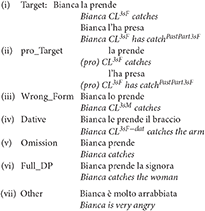
Results
Analyses of the Use of 3DO Clitics
As we can observe in Figure 1, children produced less 3DO clitics than adults did and less 3DO clitics in the mismatch conditions (MF, FM) than in the match conditions (MM, FF). Instead of producing a 3DO clitic, children tended to produce a post-verbal lexical full DP or to produce a clitic with a wrong gender morphology.
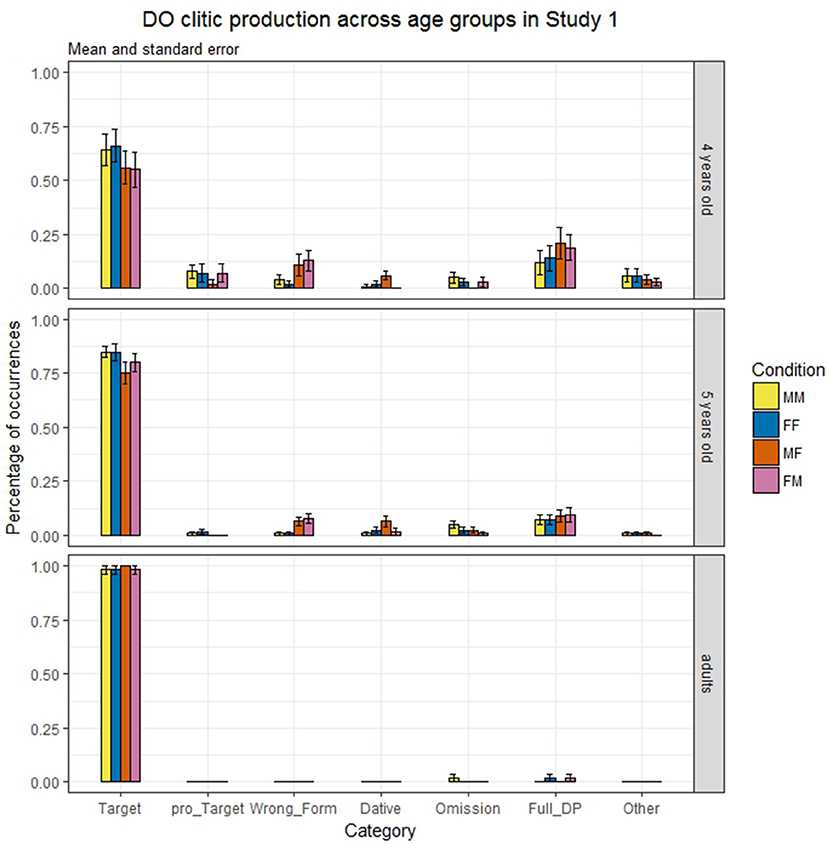
Figure 1. Study 1–3DO clitic production in each experimental condition, across age group. The error bars represent ± 1 standard error.
For the three response categories with a higher number of occurrences (Target, Wrong_Form and Full_DP) we carried out a mixed model logistic regression analysis, with Age Group (4–5 years–adults, with 5 years as reference level), Condition (match-mismatch) and Clitic Gender as fixed factors, Subject and Items as random factors, and Response as a binomial dependent variable for each response category. We included in our analysis the Age Group × Condition and the Condition × Clitic Gender interaction and we used a backward elimination procedure. All statistical analyses were run using R (version 3.4.3; R Core Team, 2017).
As shown in Table 2, the analyses revealed a main effect of Condition (higher accuracy in the match condition compared to the mismatch condition) and Age Group (higher accuracy in 5 years old children compared to 4 years old children and higher accuracy in adults compared to 5 years old children) in the production of Target sentences. In the production of Wrong_Form sentences, the analysis revealed a main effect of Condition due to the facts that children incorrectly produced more 3DO clitics with the morphology of the subject in the mismatch condition. In the production of Full_DP sentences we found a main effect of Age Group with adults different from 5-years-old children, but no significant difference between 5-years-old and 4-years-old children, due to the fact that both groups produced more full lexical DPs than 3DO clitics in order to avoid an intervening configuration. In all analyses, we did not find any significant interaction nor an effect of Clitic Gender.
Lexical Abilities and the Production of 3DO Clitics
Children were administered the TNT lexical comprehension task, the TNT lexical production task and the TNT semantic fluency task in order to have a standardized measure of children's linguistic abilities. In order to evaluate the impact of linguistic competence in lexical comprehension, production and semantic fluency on clitic production, we ran a number of repeated measures logistic regression analyses, with TNT lexical comprehension scores (TNT_Comp), TNT lexical production scores (TNT_Prod) TNT semantic fluency scores (TNT_Sem), Age Group (4–5 years) and Condition (match-mismatch) as fixed factors, Subject and Items as random factors and Response as a binomial dependent variable for each response category. No main effects nor or interactions were found in the analyses, neither with TNT raw scores nor with clustered scores.
Executive Functions and the Production of 3DO Clitics
We evaluated the impact of children's short-term memory resources and attention and inhibition resources on the ability to produce 3DO clitics. Short-term memory resources were measured by the DspanT, attention and inhibition by the TRT. In order to evaluate the impact of short-term memory, we divided the children into two groups according to their digit span. A group of children had a Dspan score lower than 4 (LowSpan, 32 children with a mean age of 4;11 years) and a group of children had a Dspan score equal or higher than 4 (HighSpan, 13 children with a mean age of 5;4 years). As we can see from Figure 2, children with a low Dspan produced less 3DO clitics in general and had particular problems in the mismatch condition where they tended to produce full post-verbal DPs and 3DO clitics with the wrong gender morphology instead.
For each response category, we evaluated the impact of memory resources on the production of 3DO clitics in a number of repeated measures logistic regression analyses, with Dspan Group (HighSpan-LowSpan), Age Group (4–5 years) and Condition (Match-Mismatch) as fixed factors, Subject and Items as random factors and productions of response categories as a binomial dependent variable. The analysis of Target sentences revealed a main effect of Condition, a main effect of Dspan Group and an interaction between the two factors. As shown by the coefficients reported in Table 3, the mismatch condition was particularly challenging for children with a low Dspan. As for the production of Wrong_Form sentences, there was a main effect of Condition, with more wrong clitics in the mismatch condition, whereas the effect of Dspan Group was only marginally significant. Considering Full_DP sentences, the effect of Dspan Group was significant, with more Full_DP sentences in children with low span than in children with high span. The effect of Condition was only marginally significant.
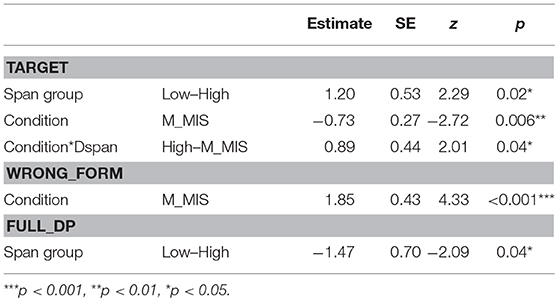
Table 3. Statistical analyses of 3DO clitic production and memory (M, Match; MIS, Mismatch; Low, Low span group; High, High span group) in Study 1.
In order to further analyze the correlation between short-term memory resources and the ability to produce 3DO clitics in sentences with an intervening lexical subject we ran a Pearson correlation between the scores of production of Target sentences in the mismatch condition and the scores at the DspanT. The analysis revealed a moderate correlation (r = 0.4709, p = 0.001). Analyses of attention and inhibition resources as measured by the TRT did not reveal any significant effect.
We additionally considered the correlation between the different lexical abilities and executive functions. The analyses revealed a strong correlation between the scores of the different TNT tasks and between Age and scores at all task but the TNT_Sem; TRT scores only correlated with Age (Table 4).
Discussion for Study 1
In Study 1 we investigated whether a lexical subject intervenes in 3DO clitic production and whether executive functions modulate the achievement of complex morphosyntactic operations needed for 3DO clitic derivation. Our results showed that, in sentences with a mismatch in gender features between the lexical subject and the 3DO clitic, children might produce the clitic with the incorrect gender morphology, regardless of the gender of the target 3DO clitic; moreover, children occasionally substitute the 3DO clitic with a full lexical post-verbal DP. This suggests that the lexical subject intervenes in the agreement relations involving the 3DO clitic during its derivation.
Measures of executive functions suggest that while auditory inhibition does not influence 3DO clitics production, short-term memory resources modulate it in conditions of structural complexity due to intervening configurations. The fact that auditory inhibition does not influence 3DO clitics production might be explained by considering that auditory inhibition is probably more crucial for language comprehension than production. In fact, in comprehension, the features of the lexical subject are activated before the features of the silent pro (or the full 3DO clitic if we assume a movement analysis of clitics) and thus, when hearing a lexical subject of a sentence with a 3DO clitic, hearers should inhibit its features and wait for the 3DO clitic and use its features in order to achieve agreement correctly. Since this is not the case in production, because the features of the subject are not activated before the features of the silent pro, we expect auditory inhibition not to influence 3DO clitics production. In production, it is rather required to handle a complex agreement configuration in which a high accessible position might intervene between the silent pro and ClP. Under short-term memory limitations, this operation might fail, because features of the subject might reverberate during the retrieval as we discussed in the previous sections. Interestingly, while short-term memory modulates 3DO clitic production and thus it is crucial for the accomplishment of morphosyntactic operations, analyses of Pearson's correlation suggest that it is not relevant for the accomplishment of comprehension and production in lexical tasks.
To summarize, in Study 1 we investigated whether a lexical subject might have an impact on 3DO clitic production and we observed that when there is a gender feature mismatch between the subject and the 3DO clitic children might make clitic gender errors or even replace the 3DO clitic with a post-verbal full DP. We proposed an interference explanation of our findings in which the feature of the lexical subjects intervene when retrieving features of the pro. Important questions for this account is whether intervention is determined by the fact the DP features are encoded at a lexical level and whether there is a morpho-phonological attraction that determines the production of the morpho-phonological form of the 3DO clitic. In other words, we need to understand whether the observed interference phenomena are structurally determined or whether they are based on surface phonology. Study 2 was meant to answer this question.
Study 2: 3DO Clitic Production With pro Intervention
In Study 2, we investigated whether the problems in 3DO clitic production found in Study 1 depended on a phonological attraction or on structural intervention. In Study 2, we elicited the production of 3DO clitics in sentences with a null subject. Analogously to Study 1, children were additionally tested in the TNL, Raven's, the DspanT, and the TRT.
Participants
Nineteen typically developing monolingual Italian children aged 4–6 years and eleven Italian monolingual adult controls were tested in Study 2. Since in Study 1 we found problems in 3DO clitic production still at age 5 years, only one group of 5 years old children participated in the study (M = 5;6 years, SD = 3.5 months). No child participating in Study 2 participated in Study 1. Children were recruited from schools and kindergartens in the same area as children participating in Study 1. No child was receiving clinical services. All children had non-verbal IQ within normal limits as measured by Raven's matrices and they all had age appropriate scores at the TNL and the TRT. Children's scores are reported in Table 5. Children were tested in a quiet room at their schools in three different sessions on different days within 2 weeks. Written informed consent was collected from children's parents and adult participants prior to testing. The study was approved by the Ethics Committee of the University of Milano-Bicocca (prot. 20974/13) according to the standards of the Helsinki Declaration (1964).

Table 5. Background information for the three groups of participants in Study 2: mean age; raw score means, centiles and standard deviations (SDs) at Raven's; Dspan raw score means and SDs; TNL raw score means, T-point means and SDs at lexical comprehension task, lexical production task and semantic fluency task; raw score means, centiles and SDs at the TRT.
Materials and Procedure
In Study 2, we tested the production of twenty sentences containing a null subject and a third singular 3DO clitic. The experimental design and procedures used in Study 2 are parallel to those employed in study 1. Analogously to Study 1, we manipulated the gender of the pro antecedent and the gender of 3DO clitic in a 2x2 experimental design and we elicited five sentences for condition. Examples of elicited sentences in the four conditions are reported below
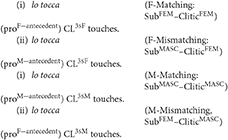
Notice that in both matching and mismatching conditions (i, ii vs. iii, iv) the sentences are identical (superficially). What changes is the gender of the antecedent of pro. During the elicitation task, children were presented couples of drawings with a character performing an action on someone. While watching the first drawing, representing the character and the object of the action, children heard a sentence saying what the character would do. While watching the second drawing, showing the character doing the action to the object, children were asked to answer a question eliciting a sentence containing a direct object clitic. A trial example is represented below:
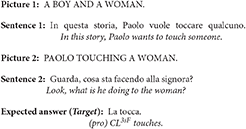
In the experimental context, a felicitous continuation of the story was a sentence with a null subject and a 3DO clitic. This allowed us to investigate whether a gender mismatch between a null subject and a 3DO clitic impacts on children's ability to produce sentences containing 3DO clitics. Descriptions and eliciting prompts were digitally recorded by a male native speaker of Italian and played through loudspeakers connected to the PC. The 20 experimental trials were randomly ordered. Three familiarization trials preceded the experimental session; feedback was given during the familiarization session when needed.
Response Coding
Response coding for the elicitation task of Study 2 was the same of the coding of the elicitation task of Study 1, apart from the occurrence of the overt lexical subject. A list of children's responses categories together with response examples for the elicitation task of Study 2 is given below:
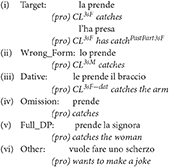
Results
Analyses of the Use of 3DO Clitics
As we can observe in Figure 3, children produced less 3DO clitics than adults did. The critical conditions seem to be the two mismatch conditions. Analogously to Study 1, children tended to produce a post-verbal lexical full DP or to produce a clitic with a wrong gender morphology instead of producing a 3DO clitic.
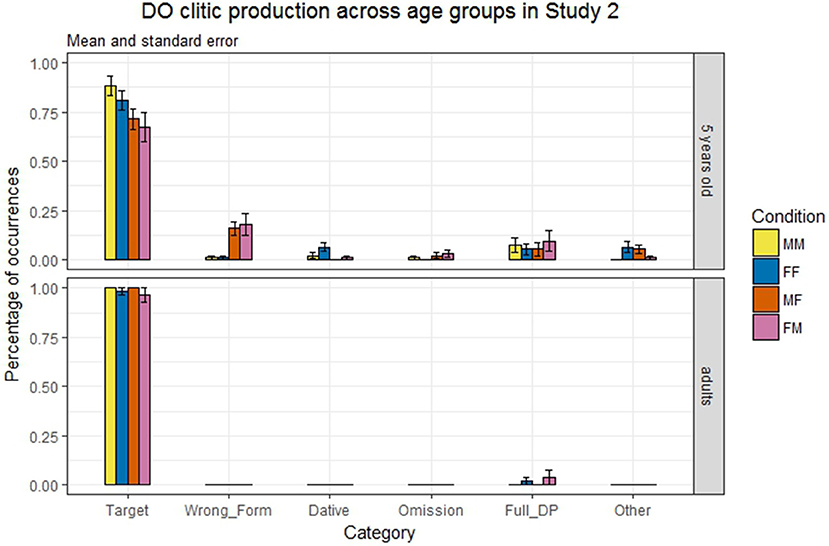
Figure 3. Study 2–3DO clitic production in each experimental condition, across age group. The error bars represent ± 1 standard error.
As in Study 1, for the three most frequent response categories (Target, Wrong_Form, Full_DP) we carried out a mixed model logistic regression analysis, with Age Group (5 years–adults), Condition (match-mismatch) and Clitic Gender as fixed factors, Subject and Items as random factors, and Response as a binomial dependent variable for each response category. We included in our analysis the Age Group × Condition and the Condition × Clitic Gender interaction and we used a backward elimination procedure. As shown by the coefficients reported in Table 6, the analyses revealed a main effect of Condition and Age Group in the production of Target sentences. In the production of Wrong_Form sentences the analysis revealed a main effect of Condition. The analysis did not reveal any other effect or interaction between these factors, and no effects were found in the Full_DP analysis.
Lexical Abilities and the Production of 3DO Clitics in Study 2
As in Study 1, children participating in Study 2 were administered the TNT tasks in order to evaluate their linguistic competence and the impact of lexical abilities on 3DO clitic production. To this aim, we run a number of repeated measures logistic regression analyses, with TNT_Comp scores, TNT_Prod scores, TNT_Sem scores and Condition (match-mismatch) as fixed factors, Subject and Items as random factors and Response as a binomial dependent variable for each response category. No effects or interactions were found in the analyses, neither with TNT raw scores nor with clustered scores.
Executive Functions and the Production of 3DO Clitics in Study 2
As in Study 1, in order to evaluate the impact of short-term memory, we divided the children into two groups according to their digit span as measured by the DspanT: a group of eleven children with a Dspan score lower than 4 (LowSpan, mean age 5;6 years) and a group of eight children with a Dspan score equal or higher than 4 (HighSpan, mean age 5;6 years). As we can see from Figure 4, children with a low Dspan produced less 3DO clitics and had particular problems in the mismatch condition where they tended to produce full post-verbal DPs and 3DO clitics with the wrong gender morphology instead.
As in Study 1, for three response categories (Target, Wrong_Form, Full_DP), we evaluated the impact of memory resources on the production of 3DO clitics. We performed different logistic regression analyses, with Dspan Group (HighSpan-LowSpan) and Condition (match-mismatch) as fixed factors, Subject and Items as random factors and productions of response categories as a binomial dependent variable. The analyses revealed a main effect of Condition and an interaction between Condition and Dspan Group in the production of Target sentences. Moreover, we found a main effect of Condition in the production of Wrong_Form sentences. As shown by the coefficients reported in Table 7, the mismatch condition was particularly challenging for children with a low Dspan.
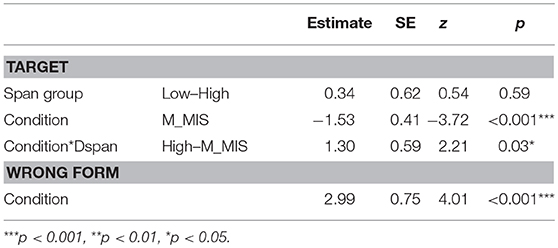
Table 7. Statistical analyses of 3DO clitic production and memory (M, Match; MIS, Mismatch; Low, Low span group; High, High span group) in Study 2.
In order to further analyze the correlation between short-term memory resources and the ability to produce 3DO clitics in sentences with an intervening pro subject we run an analysis of the Pearson correlation between the scores of production of Target sentences in the mismatch condition and the scores at the DspanT. The analysis revealed a marginally significant moderate correlation (r = 0.44, p = 0.059). Analyses of attention and inhibition resources as measured by the TRT did not reveal any significant effect.
As for Study 1, we additionally considered the correlation between the different lexical abilities and executive functions. We analyzed Pearson correlations between scores at the different TNT tasks, scores at the DspanT and at the TRT. Also in this case, the analyses revealed a correlation between the scores of the different TNT tasks and marginally significant between Age and scores at the lexical production task; TRT scores only correlate with Age (Table 8).
Discussion for Study 2
In Study 2 we investigated whether the problems in 3DO clitic production found in Study 1 depended on phonological priming (the final vowel of the subject primes the vowel stem of the linearly adjacent clitic) or on structural intervention. In this study, we elicited the production of 3DO clitics in sentences with a null subject and, analogously to Study 1, children were additionally tested in the TNL, Raven's, the DspanT and the TRT.
Our results show that, in sentences with a mismatch in gender features between the null subject and the 3DO clitic, children tend to omit the 3DO clitic and replace it with a full lexical post-verbal DP or to produce a clitic with the incorrect gender, regardless of the gender of the target 3DO clitic. This suggests that a null subject intervenes in the same way a lexical subject does in the derivation of 3DO clitics and, consequently, that the gender features inherited by a null subject via its anaphoric link with its antecedent have the same grammatical status of gender features conveyed at a lexical level. Results indicate that the interference errors are not dependent on phonological attraction but have rather a structural nature. This is further indicated by the fact that measures of auditory inhibition do not influence 3DO clitics production. On the contrary, our results indicate that short-term memory resources modulate 3DO clitics production. The results of the analyses of Pearson's correlations confirm that, while short-term memory is crucial for the accomplishment of complex morphosyntactic operations, it not relevant for the accomplishment of lexical tasks.
General Discussion
In our study, we investigated whether 3DO clitic omissions and errors depend on intervention phenomena arising during agreement operations achieved with limited working memory resources. We argued that the production of 3DO clitics is particularly challenging because it requires the accomplishment of agreement operations ending up in a syntactic configuration where an argumental chain from the object position to the ClP crosses the external verb argument (the subject, at an intermediated abstract representation of the sentence). According to the intervention model of 3DO clitic production we discussed in the previous sections, during agreement operations, an item initially merged in the verbal object position should be retrieved from working memory while an item merged in the external verb argument position reverberates and is more accessible due to its features: the external verb argument is endowed with a subset of features of the verbal object, it is in the c-commanding domain of the functional projection triggering agreement and movement of the verbal object, and it is closer to the functional projection than the verbal object. Concerning this fact, notice than in a minimalist model of syntactic sentence derivation we discussed in the first sections, in order to avoid the potential intervention of an intermediate projection in the agreement relation between two nodes, Agree is constrained by a locality checking condition requiring that a feature Fů on a node B agrees with a matching feature F on D if there is no intervening node C endowed with F (C intervenes between B and D if and only if B c-commands C and C c-commands D). We believe that, in the intervention model we are proposing, this requirement is what presumably makes the item merged in the external verb argument position more accessible than the item initially merged in the verbal object position for a cue-based memory retrieving operation.
Our results confirm the prediction that children with limited short-term memory resources have problems with 3DO clitic production and tend to produce 3DO clitics with the incorrect gender morphology in the gender mismatch condition. This indicates that features of the external verb argument (the subject) are evaluated in the clitic functional projection (ClP in Sportiche's approach) instead of the features of the verb object. This result is in line with recent findings reported in the literature. For instance, Delage et al. (2016) and Zesiger et al. (2010) reported that young monolingual French children made gender errors and Tuller et al. (2011) reported that 17% of 3DO clitics produced by 6 years old monolingual French children contained a gender error, mostly in a subject-clitic gender mismatch configuration. In our results, we did not find omissions, presumably because the children participating in the study were old enough to know that an object of a transitive verb should be overtly realized in Italian.
Since in our study the same pattern of error was found in both sentences with an overt and a covert subject, our results further suggest that agreement errors in clitic production are dependent on structural factors as described in the intervention model we are proposing and not by phonological attraction phenomena. This fact further suggests that gender feature conveyed at a lexical level and features inherited through an anaphoric dependency play the same role in agreement operations8.
Interestingly, our results are also relevant for clinical investigation and rehabilitation since they describe a factor of complexity of 3DO clitic production that clinical population might not be able to handle and they offer an indication of how materials to evaluate 3DO clitic production in clinical populations should be developed (starting from sentences with matching of features between subject and object and moving to sentences with mismatch of features). For instance, since 3DO clitic omission is a clinical marker of SLI, as described in the introduction, results from our study should be taken into consideration in clinical practice with SLI children.
Our study opens a number of questions concerning whether different features might elicit a different pattern of 3DO clitic production. For instance, the question of whether a number mismatch between the 3DO clitic and the sentence subject would elicit 3DO clitic omission or intervention of the clitic in the subject agreement operation resulting in subject-verb agreement errors as reported by Franck et al. (2006). Along with these considerations, it would be important to consider the animacy of the 3DO clitic referent. Another important question concerns whether the interference configuration modulating 3DO clitic production have effects on their comprehension.
Author Contributions
FA conceived and designed the work, acquired and analyzed the data, and drafted the article. BG revised the article and produced the figures. FA and BG contributed to final manuscript revision, read, and approved the submitted version.
Conflict of Interest Statement
The authors declare that the research was conducted in the absence of any commercial or financial relationships that could be construed as a potential conflict of interest.
Footnotes
1. ^In more recent formulations both Merge and Move are motivated by Agree and Move is described as a special case of “Merge” called “Internal Merge”, where an object, already merged in a syntactic structure is merged with the whole structure again (see Chomsky, 2004).
2. ^We assumed that once the unvalued case feature on N gets valued it its deleted. See Pesetsky and Torrego (2011) for a discussion about the interpretability of case. The same observation holds for Infl on υ and Φ whose semantic interpretability is controversial.
3. ^This holds for both a movement analyses of 3DO clitic derivation (Kayne, 1975; Belletti, 1999; among others) and mixed and based-generation analyses in which 3DO clitics are agreement morphemes (Suñer, 1988; Sportiche, 1992/1996; among others). See next section for a discussion on 3DO clitic derivation.
4. ^Notice that while in English attraction errors are elicited by plural post-nominal modifiers but not by singular ones and this asymmetry has been accounted in terms of markedness of plural forms percolating upwards in the subject constituent [a plural form is associated with a marked +plural feature while a singular form is an unmarked default form (Bock and Eberhard, 1993; Vigliocco and Nicol, 1998)], the existence of such an asymmetry is controversial for French and Italian (Franck et al., 2002; Garraffa and Di Domenico, 2016).
5. ^See Manzini and Savoia (2007) for a discussion about a base generation approach where clitics are inflectional heads and the role of pro in Sportiche mixed approach.
6. ^Notice that, according to (21), 3DO clitics potentially trigger intervention phenomena twice in the course of their derivation. In fact, first, a constituent located in verbal object position should established an agreement relation with a functional projection across an intervening constituent in the external verb argument position, then, at a later stage of the sentence derivation, the constituent in the external verb argument position should established an agreement relation with a functional projection across the object that moved outside the VP [AgrS as argued by Franck et al. (2006)].
7. ^Notice that, in proposals where case triggers the clitic movement (e.g., Belletti, 1999), case is checked in an agreement configuration involving other φ features such us number and gender (Chomsky, 1995). This is suggested by the fact that case and the other features have a syncretic morphological realization in languages like Italian; for instance the 3DO clitic la (her) is morphologically marked for Case, Gender, Number and Person (Accusative, Feminine, Singular, 3rd). Under this assumption, in Belletti's (1999) proposal an AgrO head, endowed with these features, will attract the clitic for agreement checking. Since case is checked in an agreement configuration involving other φ features such us number and gender and that the subject is a potential intervener endowed with a subset of the features of the clitic that are relevant for agreement operations, the subject might be attracted in AgrOP instead of the clitic. An analogous argumentation holds for mixed and base generated approaches since clitic projections always surface with number and gender morphology.
8. ^These results are challenging for a featural Relativized Minimality (fRM) account of 3DO clitic omission and production errors. According to fRM (Rizzi, 1990, 2001, 2004), the local relation between an extracted element and its origin is disrupted when there is an intervening element whose morphosyntactic featural specification matches the specification of the extracted element [see Villata et al. (2016) for discussion and experimental findings with adults]. Acquisition studies on relative clause and wh-question in a fRM model showed that an inclusion relation between the feature set of intervener and the feature set of the extracted element disrupts the local relation between an extracted element and its origin in children (Friedmann et al., 2009; Belletti et al., 2012; Contemori and Belletti, 2013) As we discussed, the external verb argument acts as intervener between the clitic (or pro) and its origin during DO clitic derivation and it is endowed with a subset of features of the clitic. If we assume that gender features are active in triggering the movement of the clitic, fRM predicts gender mismatch conditions to be less problematic than matching conditions, and this is not borne out of our results. Moreover, if we assume that a D is an active feature in triggering the movement of the clitic, fRM predicts sentences with a full lexical subject to be less problematic than sentences with a null subject, and this is not borne out of our results.
References
Adger, D., and Svenonius, P. (2011). “Features in minimalist syntax,” in The Oxford Handbook of Linguistic Minimalism, ed C. Boeckx (Oxford: Blackwells), 27–51.
Arnet, N., and Wagers, M. (2017). Subject encodings and retrieval interference. J. Mem. Lang. 93, 22–54. doi: 10.1016/j.jml.2016.07.005
Arosio, F., Branchini, C., Barbieri, L., and Guasti, M. T. (2014). Failure to produce direct object clitic pronouns as a clinical marker of SLI in school-aged Italian speaking children. Clin. Linguist. Phon. 28, 639–663. doi: 10.3109/02699206.2013.877081
Audollent, C., and Tuller, L. (2003). La dysphasie: quelles séquelles en français? ANAE 74–75, 264–270.
Badecker, W., and Kuminiak, F. (2007). Morphology, agreement and working memory retrieval in sentence production: evidence from gender and case in Slovack. J. Mem. Lang. 56, 65–85. doi: 10.1016/j.jml.2006.08.004
Bedore, L. M., and Leonard, L. B. (2001). Grammatical morphology deficits in Spanish-speaking children with specific language impairment. J. Speech Lang. Hear. Res. 44, 905–924. doi: 10.1044/1092-4388(2001/072)
Belacchi, C., Scalisi, T. G., Cannoni, E., and Cornoldi, C. (2008). Matrici progressive di raven forma colore (CPM-47): Manuale d'uso e standardizzazione italiana [Raven Colored Progressive Matrices (CPM-47): Manual and Italian Standardization]. Florence: Organizzazioni Speciali.
Belletti, A. (1990). Generalized Verb Movement: Aspects of Verb Syntax. Torino: Rosenberg et Sellier.
Belletti, A. (1994a). Case checking and clitic placement: three issues in (Italian/Romance) clitics. GenGenP 1.2, 101–118.
Belletti, A. (1994b). “Verb positions. evidence from Italian,” in Verb Movement, eds D. Lightfoot, and N. Hornstein (Cambridge: Cambridge University Press), 19–40.
Belletti, A. (1999). “Italian/Romance clitics: structure and derivation,” in Clitics in the Language of Europe, ed H. van Riemsdijk (Berlin: Mounton de Gruyter), 543–579.
Belletti, A., Friedmann, N., Brunato, D., and Rizzi, L. (2012). Does gender make a difference? Comparing the effects of gender on children's comprehension of relative clauses in Hebrew and Italian. Lingua 122, 1053–1069. doi: 10.1016/j.lingua.2012.02.007
Bock, K., and Cutting, J. C. (1992). Regulating mental energy: performance units in language production. J. Mem. Lang. 31, 99–127. doi: 10.1016/0749-596X(92)90007-K
Bock, K., and Eberhard, K. M. (1993). Meaning, sound and syntax in English number agreement. Lang. Cogn. Process. 8, 57–99. doi: 10.1080/01690969308406949
Bock, K., and Miller, C. (1991). Broken agreement. Cogn. Psychol. 23, 45–93. doi: 10.1016/0010-0285(91)90003-7
Borer, H. (1983). Parametric Syntax: Case Studies in Semitic and Romance Languages. Dordrecht: Foris Publication.
Borer, H. (1986). “The syntax of pronominal clitics,” in Syntax and Semantics 19, ed H. Borer (New York, NY: New York Academic Press).
Bortolini, U., Caselli, M. C., Deevy, P., and Leonard, L. B. (2002). Specific Language Impairment in Italian: the first steps in the search for a clinical marker. Int. J. Lang. Commun. Disord. 37, 77–93. doi: 10.1080/13682820110116758
Bortolini, U., and Leonard, L. B. (1996). Phonology and grammatical morphology in specific language impairment: accounting for individual variation in English and Italian. Appl. Psycholinguist. 17, 85–104. doi: 10.1017/S0142716400009474
Caprin, C., and Guasti, M. T. (2009). The acquisition of morphosyntax in Italian: a cross-sectional study. Appl. Psycholinguist. 30, 23–52. doi: 10.1017/S0142716408090024
Cardinaletti, A., and Starke, M. (1999). “The typology of structural deficiency on the three grammatical classes. A case study of the three classes of pronouns,” in Clitics in the Languages of Europe, ed H. van Riemsdijk (Berlin: de Gruyter), 145–233.
Chinellato, P. (2004). Disturbi di sintassi nell'afasia fluente: un'analisi linguistica dell'agrammatismo italiano e dialettale. PhD Thesis. University of Padova.
Chomsky, N. (1995). A Minimalist Program for Linguistic Theory (Occasional Papers in Linguistics). Cambridge, MA: The MIT Press.
Chomsky, N. (2000). “Minimalist inquiries,” in Step by Step: Essays on Minimalist Syntax in Honor of Howard Lasnik, eds R. Martin, D. Michaels, and J. Uriagereka (Cambridge, MA: The MIT Press), 89–156.
Chomsky, N. (2004). “Beyond explanatory adequacy,” in Structure and Beyond: The Cartography of Syntactic Structures, Vol. 3, ed A. Belletti (Oxford, New York, NY: Oxford University Press), 104–131.
Cinque, G. (1999). Adverbs and Functional Heads: A Cross-Linguistic Perspective. Oxford; New York, NY: Oxford University Press.
Coene, M., and Avram, L. (2011). An asymmetry in the acquisition of accusative clitics in child Romanian. Stud. Lang. Acquis. 43, 39–68. doi: 10.1515/9783110259179.39
Contemori, C., and Belletti, A. (2013). Relatives and passive object relatives in Italian-speaking children and adults: intervention in production and comprehension. Appl. Psycholinguist. 35, 1021–1053. doi: 10.1017/S0142716412000689
Cossu, G. (2013). TNL – Test Neuropsicologico lessicale per l'età evolutiva. Firenze: Edizioni Hogrefe.
Delage, H., Durrleman, S., and Frauenfelder, U. H. (2016). Disentangling sources of difficulty associated with the acquisition of accusative clitics in French. Lingua 180, 1–24. doi: 10.1016/j.lingua.2016.03.005
Dispaldro, M., Caselli, M. C., and Stella, G. (2009). Morfologia grammaticale in bambini di 2 anni e mezzo e 3 anni [Grammatical morphology in children from two and a half to three years old]. Psicologia Clinica dello Sviluppo 1, 161–182. doi: 10.1044/0161-1461(2005/019)
Franck, J. (2018). “Syntactic encoding: novel insights into the relationship between grammar and processing,” in The Handbook of Psycholinguistics, eds E. Fernández, and H. Smith Cairns (Malden; Oxford: Wiley-Blackwell), 13–37.
Franck, J., Lassi, G., Frauenfelder, U. H., and Rizzi, L. (2006). Agreement and movement: a syntactic analysis of attraction. Cognition 101, 173–216. doi: 10.1016/j.cognition.2005.10.003
Franck, J., Soare, G., Frauenfelder, U. H., and Rizzi, L. (2010). Object interference in subject–verb agreement: The role of intermediate traces of movement. J. Mem. Lang. 62, 166–182. doi: 10.1016/j.jml.2009.11.001
Franck, J., Vigliocco, G., and Nicol, J. (2002). Subject-verb agreement errors in French and English: the role of syntactic hierarchy. Lang. Cogn. Process. 17, 371–404. doi: 10.1080/01690960143000254
Friedmann, N., Belletti, A., and Rizzi, L. (2009). Relativized relatives: types of intervention in the acquisition of A-bar dependencies. Lingua 119, 67–88. doi: 10.1016/j.lingua.2008.09.002
Gallego, A. (2007). Phase Theory and Parametric Variation. PhD Thesis, Universitat Autònoma de Barcelona, Spain.
Garraffa, M., and Di Domenico, A. (2016). Interference in processing agreement: the impact of grammatical cues. J. Psycholinguist. Res. 45, 337–358. doi: 10.1007/s10936-015-9351-9
Gavarró, A. (2012). “Third person clitic production and omission in Romance SLI,” in Pronouns and Clitics in Early Language, eds P. Guijarro Fuentes and P. Larrañaga (Berlin: De Gruyter Mouton), 79–104.
Gavarró, A., and Fortón, N. (2014). “Person features and the acquisition of clitics,” in Inquiries Into Linguistic Theory and Language Acquisition. Papers offered to Adriana Belletti, eds C. Contemori, and L. Dal Pozzo (Siena: CISCL Press).
Gavarró, A., Torrens, V., and Wexler, K. (2010). Object clitic omission: two language types. Lang. Acquis. 17, 192–219. doi: 10.1080/10489223.2010.509262
Gerken, L. A. (1991). The metrical basis for children's subjectless sentences. J. Mem. Lang. 30, 431–451.
Gerken, L. A. (1994). Young children's representation of prosodic structure: evidence from English speakers' weak syllable omissions. J. Mem. Lang. 33, 19–38.
Gerken, L. A. (1996). Prosodic structure in young children's language production. Language 72, 683–712.
Gordon, P. C., Hendrick, R., and Johnson, M. (2001). Memory interference during language processing. J. Exp. Psychol. Learn. Mem. Cogn. 27, 1411–1423. doi: 10.1037/0278-7393.27.6.1411
Grüter, T., and Crago, M. (2012). Object clitics and their omission in child L2 French: the contributions of processing limitations and L1 transfer. Biling. Lang. Cogn. 15, 531–549. doi: 10.1017/S1366728911000113
Guasti, M. T. (1993/1994). Verb syntax in Italian child grammar: finite and nonfinite verbs. Lang. Acquis. 3, 1–40. doi: 10.1207/s15327817la0301_1.
Hamann, C., Rizzi, L., and Frauenfelder, U. H. (1996). “On the acquisition of subject and object clitics in French,” in Generative Perspectives on Language Acquisition, ed H. Clahsen (Amsterdam: Benjamins), 309–334
Jaeggli, O. (1986). “Three issues in the theory of clitics: case, doubled NPs, and extraction,” in Syntax and Semantics 19: The Syntax of Pronominal Clitics, ed H. Borer (Orlando: Academic Press), 15–42.
Jakubowicz, C., Nash, L., Rigaut, C., and Gerard, C. L. (1998). Determiners and clitic pronouns in French speaking children with SLI. Lang. Acquis. 7, 113–160. doi: 10.1207/s15327817la0702-4_3
Kratzer, A. (1996). “Severing the external argument from its verb,” in Phrase Structure and the lexicons, eds J. Rooryck, and L. Zaring (Dordrecht: Kluwer), 109–138.
Leonini, C. (2006). The Acquisition of Object Clitics and Definite Articles: Evidence From Italian as L2 and L1. PhD. Thesis, Università degli Studi di Firenze, Italy.
Lewis, R. L., and Vasishth, S. (2005). An activation-based model of sentence processing as skilled memory retrieval. Cogn. Sci. 29, 375–419. doi: 10.1207/s15516709cog0000_25
Lonzi, L., and Luzzatti, C. (1993). Relevance of adverb distribution for the analysis of sentence representation in agrammatic patients. Brain Lang. 45, 306–317. doi: 10.1006/brln.1993.1048
Manly, T., Robertson, I. H., Anderson, V., and Nimmo-Smith, I. (1999). The Test of Everyday Attention for Children (TEA-CH). Bury St. Edmunds: Thames Valley Test Company.
Manzini, M. R., and Savoia, L. M. (2007). “A unification of morphology and syntax,” in Studies in Romance and Albanian Dialects (London: Routledge).
Marzocchi, G. M., Re, A., and Cornoldi, C. (2010). BIA–Batteria italiana per l'ADHD per la valutazione dei bambini con deficit di attenzione/iperattività. Trento: Erickson.
Mateu, V. E. (2015). Object clitic omission in child Spanish: evaluating representational and processing accounts. Lang. Acquis. 22, 240–284. doi: 10.1080/10489223.2014.962232
Miceli, G., and Mazzucchi, A. (1990). “Agrammatism in Italian: two case studies,” in Agrammatic Aphasia: A Cross Linguistic Narrative Sourcebook, eds L. Menn, and L. Obler (Amsterdam: Benjamins), 717–757.
Miceli, G., Silveri, M.C., Romani, C., and Caramazza, A. (1989). Variation in the pattern of omissions and substitutions of grammatical morphemes in the spontaneous speech of so-called agrammatic patients. Brain Lang. 36, 447–492. doi: 10.1016/0093-934X(89)90079-5
Moscati, V., and Tedeschi, R. (2009). “The delay of Italian past participle agreement,” in BUCLD 33: Proceedings of Annual Boston University Conference on Language Development, eds J. Chandlee, M. Franchini, S. Lord, and G. M. Rheiner (Somerville, MA: Cascadilla Press), 379–390.
Nicol, J. L. (1995). Effects of clausal structure on subject-verb agreement errors. J. Psycholing. Res. 24, 507–516. doi: 10.1007/BF02143164
Paradis, J., Crago, M., and Genesee, F. (2005/2006). Domain-specific versus domain-general theories of the deficit in SLI: object pronoun acquisition by French–English bilingual children. Lang. Acquis. 13/14, 33–62. doi: 10.1207/s15327817la1301_3
Pesetsky, D., and Torrego, E. (2007). “The syntax of valuation and the interpretability of features,” in Phrasal and Clausal Architecture, eds S. Karimi, V. Samiian, and W. K. Wilkins (Amsterdam: John Benjamins), 262–294.
Pesetsky, D., and Torrego, E. (2011). “Case,” in Oxford Handbook of Linguistic Minimalism, ed C. Boeckx (Oxford; New York, NY: Oxford University Press), 52–72.
R Core Team (2017). R: A language and Environment for Statistical Computing. Vienna: R Foundation for Statistical Computing. Retrieved from: http://www.R-project.org
Raven, J., Court, J. H., and Raven, J. C. (1998). Raven Manual, Section 1 (General Overview) and Section 2 (Coloured Progressive Matrices). Oxford: Oxford Psychologist Press.
Reznik, M., Dubrovsky, S., and Maldonado, S. (1995). Agrammatism in Spanish: a case study. Brain Lang. 51, 355–368. doi: 10.1006/brln.1995.1065
Rizzi, L. (2001). “On the position ‘Int(errogative)’ in the left periphery of the clause,” in Current Studies in Italian Syntax, Essays Offered to Lorenzo Renzi, eds G. Cinque, and G. Salvi (Strasbourg; Amsterdam: Elsevier), 287–296.
Rizzi, L. (2004). “Locality and the left periphery,” in Structures and Beyond: The Cartography of Syntactic Structures, Vol. 3, ed A. Belletti (Oxford: Oxford University Press), 223–251.
Roberts, I. (2010). Agreement and Head movement: Clitics, Incorporation and Defective Goals. Ms. University of Cambridge. Cambridge, MA: The MIT Press.
Rossi, E. (2007). Clitic Production in Italian Agrammatism. Ph.D. Thesis, University of Groningen, The Netherlands.
Schaeffer, J. (2000). The Acquisition of Direct Object Scrambling and Clitic Placement. Amsterdam: John Benjamins.
Slioussar, N., and Malko, A. (2016). Gender agreement attraction in russian: production and comprehension evidence. Front. Psychol. 7:1651. doi: 10.3389/fpsyg.2016.01651
Smith, N., Edwards, S., Stojanovik, V., and Varlokosta, S. (2008). “Object clitic pronouns, definite articles and genitive possessive clitics in Greek preschool children with specific language impairment (SLI): implications for domain general and domain-specific accounts of SLI,” in Supplement to the Proceedings of 32nd Boston University Conference on Language Development (BUCLD 32), Boston, MA: Boston University. Available online at: http://www.bu.edu/bucld/proceedings/supplement/vol32/
Sportiche, D. (1992/1996). “Clitic constructions,” in Phrase Structure and the Lexicon, eds J. Rooryck, and L. Zaring (Dordrecht: Kluwer Academic Publishers), 213–276.
Sportiche, D. (1999). “Pronominal clitic dependencies,” in Clitics in the Languages of Europe, ed H. van Riemsdijk (Berlin: Mouton de Gruyter), 679–708.
Stavrakaki, S., and Kouvava, S. (2003). Functional categories in agrammatism: evidence from Greek. Brain Lang. 86, 129–141. doi: 10.1016/S0093-934X(02)00541-2
Suñer, M. (1988). The role of agreement in clitic-doubled constructions. Nat. Lang. Ling. Theory 6, 391–434. doi: 10.1007/BF00133904
Tsimpli, I. M. (2001). LF-interpretability and language development: a study of verbal and nominal features in Greek normally developing and SLI children. Brain Lang. 77, 432–448. doi: 10.1006/brln.2000.2413
Tsimpli, I. M., and Mastropavlou, M. (2007). “Feature interpretability in L2 acquisition and SLI: Greek clitics and determiners,” in The Role of Formal Features in Second Language Acquisition, eds J. Liceras, H. Zobl, and H. Goodluck (Mahwah, NJ: Lawrence Erlbaum).
Tsimpli, I. M., and Stavrakaki, S. (1999). The effects of a morphosyntactic deficit in the determiner system: the case of a Greek SLI child. Lingua 108, 31–85. doi: 10.1016/S0024-3841(98)00041-2
Tuller, L. H., Delage, C., Monjauze, A. C., Piller, A. G., and Barthez, M. A. (2011). Clitic pronoun production as a measure of atypical language development in French. Lingua 121, 423–441. doi: 10.1016/j.lingua.2010.10.008
Uriagereka, J. (1995). Aspects of the syntax of clitic placement in Western Romance. Ling. Inq. 26, 79–124.
Varlokosta, S., Belletti, A., Costa, J., Friedmann, N., Gavarró, A., Grohmann, K. K., et al. (2016). A cross-linguistic study of the acquisition of clitic and pronoun production. Lang. Acquis. 23, 1–26. doi: 10.1080/10489223.2015.1028628
Vasishth, S., and Lewis, R. L. (2006). Argument-head distance and processing complexity: explaining both locality and antilocality effects. Language 767–794. doi: 10.1353/lan.2006.0236
Vigliocco, G., and Nicol, J. L. (1998). Separating hierarchical relations and word order in language production. Is proximity concord syntactic or linear? Cognition 68, 13–29. doi: 10.1016/S0010-0277(98)00041-9
Villata, S., Rizzi, L., and Franck, J. (2016). Intervention effects and relativized minimality: new experimental evidence from graded judgments. Lingua 179, 76–96. doi: 10.1016/j.lingua.2016.03.004
Wagers, M. W. (2008). The Structure of Memory Meets Memory for Structure in Linguistic Cognition. Ph.D. Thesis, University of Maryland, College Park, MD.
Wexler, K. (1998). Very early parameter setting and the unique checking constraint: a new explanation of the optional infinitive stage. Lingua 106, 23–79. doi: 10.1016/S0024-3841(98)00029-1
Wexler, K. (2003). “Lenneberg's dream: learning, normal language development, and specific language impairment,” in Language Competence Across Populations: Toward a Definition of Specific Language Impairment, eds Y. Levy, and J. Schaeffer (Mahwah, NJ: Erlbaum), 11–61.
Wexler, K. (2014). “The unique checking constraint as the explanation of clitic omission in normal and SLI development,” in Developments in the Acquisition of Clitics, eds K. K. Grohmann, and T. Neokleous (Newcastle-upon-Tyne: Cambridge Scholars Publishing), 292–350.
Zanuttini, R. (1997). Negation and Clausal Structure: A Comparative Study of Romance Languages. Oxford; New York, NY: Oxford University Press.
Keywords: direct object clitic, interference, intervention, short-term memory, syntax, Italian, language acquisition, agreement
Citation: Arosio F and Giustolisi B (2019) Agreement and Interference in Direct Object Clitic Production in Italian Monolingual Children. Front. Commun. 3:66. doi: 10.3389/fcomm.2018.00066
Received: 23 May 2018; Accepted: 31 December 2018;
Published: 22 January 2019.
Edited by:
Julie Franck, Université de Genève, SwitzerlandReviewed by:
Maria Garraffa, Heriot-Watt University, United KingdomAnna Maria Di Sciullo, Université du Québec à Montréal, Canada
Copyright © 2019 Arosio and Giustolisi. This is an open-access article distributed under the terms of the Creative Commons Attribution License (CC BY). The use, distribution or reproduction in other forums is permitted, provided the original author(s) and the copyright owner(s) are credited and that the original publication in this journal is cited, in accordance with accepted academic practice. No use, distribution or reproduction is permitted which does not comply with these terms.
*Correspondence: Fabrizio Arosio, ZmFicml6aW8uYXJvc2lvQHVuaW1pYi5pdA==
 Fabrizio Arosio
Fabrizio Arosio Beatrice Giustolisi
Beatrice Giustolisi